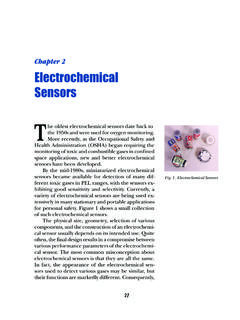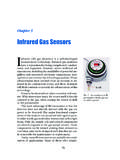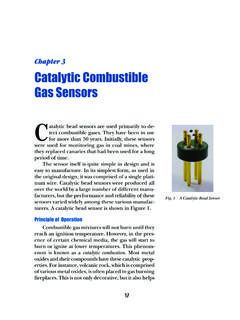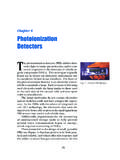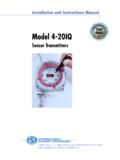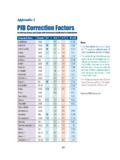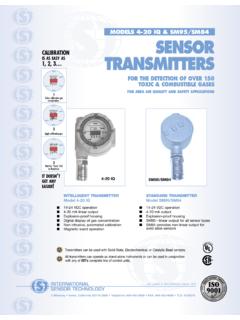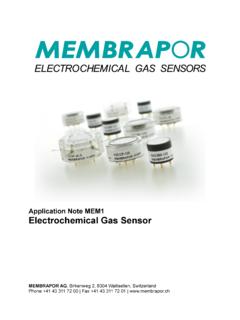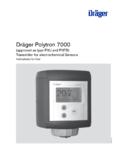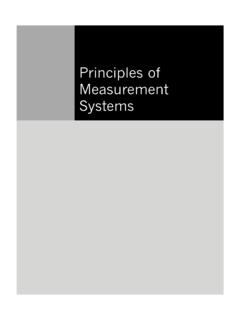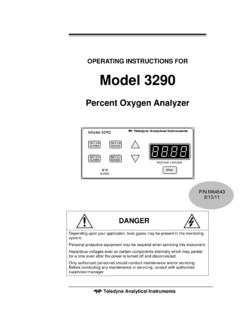Transcription of Application Requirement - International Sensor …
1 Hazardous Gas MonitorsElectrochemicalSensor Selection OverviewMonitorsAnalyzersApplication Requirement Safety Monitoring (LEL) Exposure Assessment (TWA) Toxic Limit Detection (PEL) Ambient Air Quality Compliance Monitoring Leak Detection Personal SafetyLIMIT DETECTION ALARMQUALITATIVE & QUANTITATIVE ANALYSIST oxicGasesSolid-StateCatalyticCombustible GasesInfraredSolid-StateVolatileOrganicC ompoundsPhotoionizationMonitor Type:TotalHydro-CarbonsFlame IonizationThermalConductivityOtherGasesC olorimetricAnalyzer Type:UV PhotometersUV FluorescenceTarget Gas:Multi-Gas(Laboratory)AirQualityMonit orChemiluminescenceFlame IonizationInfraredParamagnetic;Zirconium Oxide.
2 ElectrochemicalUV/IR SpectrometerFourier Transform IRMass SpectrometerGas ChromatographSingleGas(Online)O3SO2 NOxTHC*COCO2SO2O2 ContinuousEmissionMonitorMost UV/IRAbsorbing GasesMost IRAbsorbing GasesMost Gases*Total hydrocarbon103 chapter 8 Sensor Selection GuideChapter 8 Sensor Selection GuideEach of the following sensors electrochemical ,catalytic bead, solid state, infrared and photo-ionization detectors must meet certain criteriato be practical for use in area air quality and safetyapplications. Some of the basic requirements are:1. The Sensor should be designed for a housingthat is small and rugged.
3 The Sensor should be suit-able for use in hazardous locations and harsh envi-ronments, and, it should also be explosion-proof. Thesensor should be cost-effective, designed for installa-tion and use in industrial production areas, andinstallable at a reasonable For portable applications , the instrumentsshould have reasonable energy consumption and the op-tion of powering the instruments with batteries shouldbe easily available. The instruments should be smalland portable so they can be carried easily. They shouldbe safe for use in industrial environments.
4 Preferably,the instruments should be certified as intrinsically safefor use in a hazardous The operation and maintenance of the instru-ments should be easily performed by regular plantpersonnel with minimal special training In stationary installations, the sensors shouldbe able to function continuously and reliably for a periodof time, preferably longer than 30 days. The sensor104 Hazardous Gas Monitorsshould be able to function in an industrial environ-ment for at least two years or longer and should bereplaceable or renewable at a reasonable cost.
5 Itshould be easy to install into a multi-point system andbe managed by a controller or a computer controlleddistribution The cost of the instruments should be reason-able so that multiple sensors can be installed to effec-tively protect the of the five sensors discussed in this book allmeet the above criteria. The exception is the photo-ionization detector. The PID is a good detector forportable applications but is limited by the lamp be-cause it has a relatively short life expectancy and thefrequency of maintenance required may not be prac-tical for stationary applications .
6 However, there arePID stationary instruments available that can be use-ful as long as users are aware of the are other types of sensors which meet theabove criteria, but most have limitations. For ex-ample, thermal conductivity sensors are mostly usedfor high concentration applications and are not widelyused as gas to Consider When Selecting SensorsOne of the most frequently asked questions regard-ing sensors is: Which Sensor is the best? Of course,there is no simple answer to this question. Each sen-sor has certain capabilities and limitations, and thusthe suitability of a given Sensor depends largely onthe Application in which it is to be used.
7 Thus, tochoose the correct Sensor , one must first properly de-fine the Application . The illustration on page 102shows an overview of various Application requirementsand their detection technologies. It is common formanufacturers to exaggerate the capabilities of thesensors that they offer and downplay sensors that theydo not 8 Sensor Selection GuideIn determining which Sensor to use for a given ap-plication, the following factors/observations shouldbe define what objective one is trying to ac-complish and define an instrument specificationthat meets the minimum requirements .
8 Thespecifications should define the gases andranges of the sensors. The ranges or the con-centration of the gases to be measured shouldbe 3 to 5 times the actual monitoring concen-tration. As with a voltmeter, one should alwaysselect a range higher than the actual voltageto be measured. For example, select a 50-voltrange to measure a 12-volt Determine the background gases in the moni-toring area. In cases where the backgroundgases cannot be determined, a representativesample should be analyzed. A major cause ofsensor failure is the presence of backgroundgases that the instrument s manufacturers didnot take into consideration.
9 The selectivity orspecificity of the Sensor must be acceptable forthe The temperature ranges in which the Sensor isto be installed should be within the sensorspecifications and should be suitable for thegases to be monitored. For example, jet en-gine fuels have very low vapor pressure. It isuseless to install a Sensor to measure the com-bustible range in a hangar if the temperaturewill never exceed 100 F because the vaporconcentration cannot reach combustible lev-els. In this example, it is more appropriate tomeasure in ppm temperature changes between day andnight, and during summer and winter, shouldalso be considered.
10 A wide temperature change106 Hazardous Gas Monitorscan cause moisture condensation. This is par-ticularly important in a confined space such asa closed container where air circulation is A typical specification for humidity is 95% non-condensating. The occurrence of condensationis a function of temperature change, as seenon wet windows and car windshields in themorning. Normally, there is no problem innormal industrial background environments,even during the hot summer months in coastalareas such as the Gulf of Mexico, as long as theair circulation is normal.
